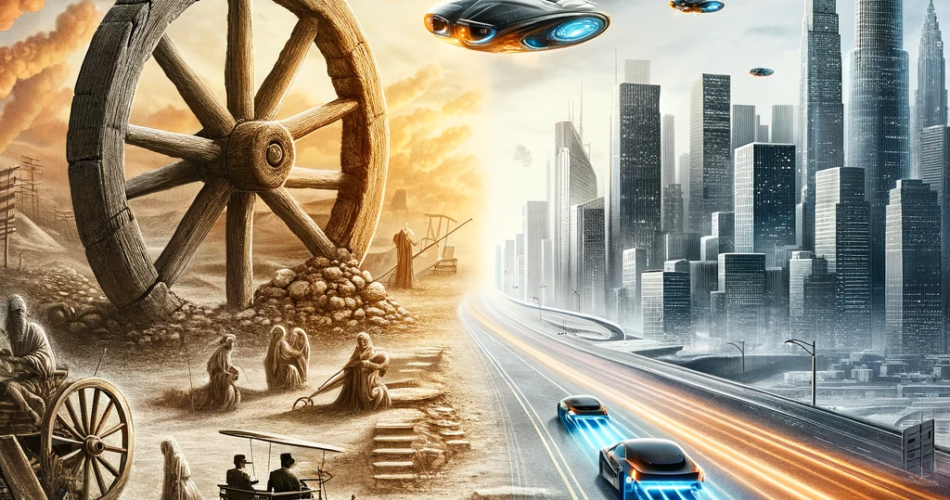Introduction
Humanity’s ability to move people, goods, and ideas has played a pivotal role in shaping the rise and fall of civilizations throughout history. The story of transportation is a fascinating journey that began over five millennia ago with the invention of the wheel by the Mesopotamians in 3,500 BC. This groundbreaking innovation, initially designed for wheel-thrown pottery, soon found its way into carts, revolutionizing the movement of goods and people.
Transportation technology has continued to evolve, leading to significant advancements that have both contributed to the creation and destruction of empires and shaped the modern world we live in today. In this article, we will explore the past, present, and future of transportation, from ancient riverboats to the potential of flying cars.
Ancient Transportation: Riverboats and Domesticated Horses
Around the same time that the wheel was invented, Mesopotamians and Egyptians were using wooden riverboats to transport people and goods. This innovation allowed thriving cities to develop near powerful water sources, fostering trade and growth.
In 2000 BCE, the Egyptians pioneered the construction of ships using assembled wood planks, woven straps, and reeds to seal the seams. Meanwhile, the domestication of horses was taking place, leading to measurable changes in their size and role in human society.
The domestication of horses played a pivotal role in the rise of the Hittite Empire, known for its mastery of the war chariot. Under the leadership of King Suppiluliuma I, the Hittites expanded their empire across modern-day Turkey, Syria, Lebanon, and Northern Iraq. Thanks to the innovative horse training techniques developed by Kikkuli, their charioteers became a formidable force during the 14th century BCE.
The Age of the Horse-Powered Society
For thousands of years, horses remained the cornerstone of human transportation. In the pre-industrial era, horses were symbols of wealth, and only the affluent could afford them for personal transportation. The majority of people relied on walking for short distances and oxen-drawn wagons for longer trips.
However, horses became invaluable during the Industrial Revolution. They were strong, versatile, and capable of navigating the poor road infrastructure of the time. As industrialists developed ports and railroads, horses became essential for moving goods and workers, serving as the backbone of 19th-century life.
By 1900, there were over 24 million horses in use, employed in various tasks from plowing fields to pulling street trolleys, brewery wagons, and carriages. However, their prevalence came with a downside—massive amounts of manure and urine in the streets, leading to sanitation challenges.
The Rise and Fall of the Horse-Powered City
The influx of immigrants, political unrest, and pollution in North American industrial cities led to a desire for cleaner and more orderly public spaces. Urban reformers championed the removal of horses from cities, predicting that cars would not only reduce noise but also save money. This marked the beginning of pro-car propaganda.
The transition from horse-powered to car-centric cities didn’t bring the promised order. Instead, it replaced visible piles of dung with air pollution. Cars allowed the wealthy to abandon public transit, and roads became congested. The growth of cars and highways led to increased oil consumption and greenhouse gas emissions.
The price of grain dropped drastically due to increased demand for car fuel, contributing to the Great Depression. Despite expanded road infrastructure, cities still faced congestion as cars clogged urban thoroughfares.
The Birth of the Interstate Highway System
In 1956, President Dwight D. Eisenhower approved funding for the construction of the United States Interstate Highway System. Inspired by his experiences as a military observer during the Transcontinental Motor Convoy, Eisenhower recognized the need for a uniform highway network.
The system, consisting of over 47,000 miles of highways, brought benefits to rural communities but had detrimental effects on cities. Highways often tore through predominantly black, lower-income urban neighborhoods, isolating them from the rest of the city. Cars, trucks, and highways reshaped the structure of cities.
Rethinking the Future of Transportation
Today, as we grapple with traffic congestion and environmental challenges caused by a car-centric society, it’s clear that we need to rethink transportation. The conveniences of city life, such as next-day shipping and food delivery, contribute to pollution and congestion.
One potential solution is the use of automated drones for delivery purposes. Electric AI-controlled flying drones are already in operation in limited markets, offering the promise of reducing street traffic and pollution.
Solar or electric-powered cars provide an eco-friendly alternative to traditional combustion engine vehicles. Self-driving cars with advanced communication capabilities aim to make transportation safer and more efficient.
Car hail apps like Uber and Lyft are looking toward a future where fully autonomous vehicles lower overhead costs, making transportation and delivery fleets more profitable.
The Future of Urban Transportation: Flying Cars
Beyond ground-based transportation, there’s potential for travel overhead. Flying cars and advanced passenger drones are on the horizon. Fully autonomous, AI-controlled passenger drones could revolutionize urban transportation, allowing for quick travel between buildings in crowded cities.
While passenger drones may offer a futuristic solution to urban congestion, they raise questions about their impact on city life. Will they lead to a divide between the affluent who can escape street-level traffic and those who cannot? What will be the unforeseen consequences of introducing advanced autonomous transportation into urban environments?
In conclusion, the evolution of transportation, from the invention of the wheel to the potential of flying cars, reflects humanity’s constant drive to improve mobility. Each era brought its challenges and solutions, shaping the way we live and interact with our cities. As we look to the future, it remains to be seen how the choices we make in transportation will shape the cities of tomorrow. Only time will reveal the path we choose and the consequences that follow.
Transportation has always been about more than just getting from point A to point B; it’s about the journey and the world we create along the way.

